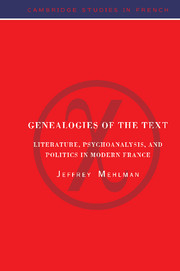Book contents
- Frontmatter
- Contents
- Acknowledgments
- 1 Introduction
- 2 Craniometry and criticism: notes on a Valéryan criss-cross
- 3 Literature and hospitality: Klossowski's Hamann
- 4 Literature and collaboration: Benoist-Méchin's return to Proust
- 5 “Pierre Menard, author of Don Quixote” again
- 6 Iphigenia 38: deconstruction, history, and the case of L'Arrêt de mort
- 7 Writing and deference: the politics of literary adulation
- 8 Perspectives: on Paul de Man and Le Soir
- 9 Prosopopeia revisited
- 10 The paranoid style in French prose: Lacan with Léon Bloy
- 11 The Holocaust comedies of “Emile Ajar”
- 12 Pour Sainte-Beuve: Maurice Blanchot, 10 March 1942
- 13 Flowers of evil: Paul Morand, the Collaboration, and literary history
- Appendix
- Notes
- Index
- Series list
11 - The Holocaust comedies of “Emile Ajar”
Published online by Cambridge University Press: 19 January 2010
- Frontmatter
- Contents
- Acknowledgments
- 1 Introduction
- 2 Craniometry and criticism: notes on a Valéryan criss-cross
- 3 Literature and hospitality: Klossowski's Hamann
- 4 Literature and collaboration: Benoist-Méchin's return to Proust
- 5 “Pierre Menard, author of Don Quixote” again
- 6 Iphigenia 38: deconstruction, history, and the case of L'Arrêt de mort
- 7 Writing and deference: the politics of literary adulation
- 8 Perspectives: on Paul de Man and Le Soir
- 9 Prosopopeia revisited
- 10 The paranoid style in French prose: Lacan with Léon Bloy
- 11 The Holocaust comedies of “Emile Ajar”
- 12 Pour Sainte-Beuve: Maurice Blanchot, 10 March 1942
- 13 Flowers of evil: Paul Morand, the Collaboration, and literary history
- Appendix
- Notes
- Index
- Series list
Summary
Throughout the 1970s, a period during which American academics seemed poised to absorb from France ever more “radical” doses of what was called literary “theory,” the readership of France itself was unwittingly embarked on an unprecedented literary experiment, of remarkable speculative import, under the tutelage of a French man of letters so apparently conventional as to identify his years of service as French consul general in Hollywood as a high point of his career. For these were the years during which Romain Gary published a series of three tonally innovative novels under the pseudonym “Emile Ajar”: Gros-Câlin (1974), La Vie devant soi (1975), and L'Angoisse du roi Salomon (1979). The critical success of the books was such that attempts were made, beyond what all took to be a fabricated biography on the book jacket of Gros-Câlin (a pied noir physician and sometime abortionist, living in Latin America, in flight from French authorities), to identify the actual author of books that were emerging as the literary achievements of France in the 1970s. Press speculation concerned only the highest echelon of the French literary pantheon: Raymond Queneau and Louis Aragon. Ajar's publisher, Mercure de France, as much in the dark as everyone else, prevailed on its author, through an intermediary, to grant an interview to the press. Gary requested his “nephew,” one Paul Pavlowitch, to play the role of Ajar in an interview with a journalist from Le Monde, in an apartment in Copenhagen, and to do so on the condition that his “actual” identity not be divulged. Pavlowitch, however, revealed enough of his own life for an old acquaintance to be able to identify him as Ajar.
- Type
- Chapter
- Information
- Genealogies of the TextLiterature, Psychoanalysis, and Politics in Modern France, pp. 154 - 173Publisher: Cambridge University PressPrint publication year: 1995

